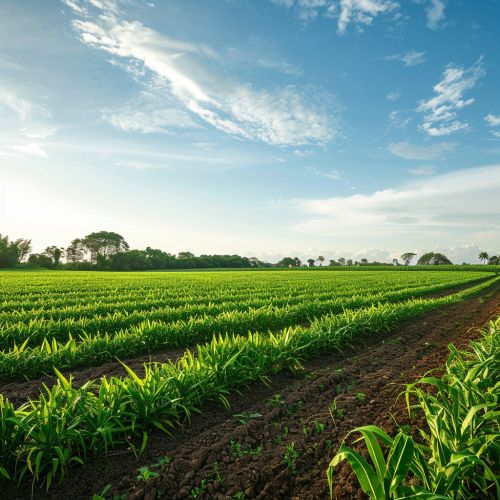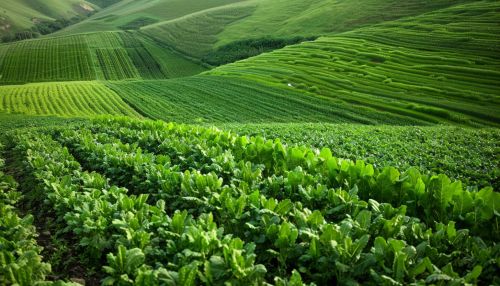Soil Degradation
Introduction
Soil degradation is a process that diminishes the capacity of soil to support agricultural, environmental, and urban activities. It encompasses a range of physical, chemical, and biological processes that lead to the deterioration of soil quality and fertility. This article delves into the various aspects of soil degradation, including its causes, types, impacts, and mitigation strategies.
Types of Soil Degradation
Soil degradation can be classified into several types based on the underlying processes:
Erosion
Soil erosion is the displacement of the upper layer of soil by natural forces such as wind and water. It is one of the most prevalent forms of soil degradation. Erosion can lead to the loss of nutrient-rich topsoil, reducing the soil's fertility and its ability to support plant growth.
Salinization
Salinization refers to the accumulation of soluble salts in the soil, which can adversely affect plant growth and soil structure. This process is often exacerbated by improper irrigation practices and poor drainage systems.
Acidification
Soil acidification is the process by which soil becomes more acidic, often due to the excessive use of chemical fertilizers and acid rain. Acidic soils can inhibit plant growth and reduce microbial activity, leading to a decline in soil health.
Compaction
Soil compaction occurs when soil particles are pressed together, reducing pore space and impeding water infiltration and root growth. This is often caused by heavy machinery, overgrazing, and trampling by livestock.
Contamination
Soil contamination involves the introduction of harmful substances such as heavy metals, pesticides, and industrial chemicals into the soil. Contaminated soils can pose significant risks to human health and the environment.
Desertification
Desertification is the process by which fertile land becomes desert, typically as a result of drought, deforestation, and inappropriate agricultural practices. It is a severe form of land degradation that affects arid and semi-arid regions.
Causes of Soil Degradation
Soil degradation is driven by a combination of natural and anthropogenic factors:
Natural Factors
Natural factors contributing to soil degradation include climatic conditions, such as heavy rainfall and strong winds, which can accelerate erosion. Geological processes, such as volcanic eruptions and earthquakes, can also disrupt soil structure and composition.
Human Activities
Human activities are the primary drivers of soil degradation. These include:
- Deforestation: The removal of vegetation cover exposes soil to erosion and reduces organic matter input.
- Agricultural Practices: Intensive farming, monocropping, and the excessive use of chemical fertilizers and pesticides can deplete soil nutrients and disrupt soil ecosystems.
- Urbanization: The expansion of urban areas leads to soil sealing, compaction, and contamination.
- Industrial Activities: Mining, waste disposal, and industrial emissions can introduce pollutants into the soil.
Impacts of Soil Degradation
Soil degradation has far-reaching consequences for the environment, agriculture, and human well-being:
Environmental Impacts
- Loss of Biodiversity: Degraded soils support fewer plant and animal species, leading to a decline in biodiversity.
- Water Quality: Eroded soils can carry sediments and pollutants into water bodies, degrading water quality.
- Climate Change: Soil degradation can release stored carbon into the atmosphere, contributing to global warming.
Agricultural Impacts
- Reduced Crop Yields: Degraded soils have lower fertility and water-holding capacity, leading to reduced agricultural productivity.
- Increased Costs: Farmers may need to invest in additional inputs, such as fertilizers and irrigation, to compensate for degraded soils.
Socio-Economic Impacts
- Food Security: Soil degradation threatens food security by reducing the availability and quality of arable land.
- Livelihoods: Many communities, especially in developing countries, rely on healthy soils for their livelihoods. Soil degradation can lead to poverty and displacement.
Mitigation Strategies
Addressing soil degradation requires a multifaceted approach that combines sustainable land management practices, policy interventions, and community engagement:
Sustainable Agricultural Practices
- Conservation Tillage: Reducing tillage minimizes soil disturbance and helps maintain soil structure.
- Crop Rotation: Rotating crops can improve soil fertility and reduce pest and disease pressures.
- Agroforestry: Integrating trees and shrubs into agricultural systems can enhance soil health and provide additional benefits such as shade and windbreaks.
Soil Conservation Techniques
- Terracing: Constructing terraces on slopes can reduce soil erosion and improve water retention.
- Contour Plowing: Plowing along the contour lines of a slope can help prevent soil erosion.
- Cover Cropping: Planting cover crops can protect soil from erosion, improve soil structure, and add organic matter.
Policy and Governance
- Land Use Planning: Implementing land use planning and zoning regulations can help protect vulnerable soils from degradation.
- Incentives and Subsidies: Providing financial incentives and subsidies for sustainable land management practices can encourage farmers to adopt soil conservation measures.
- Education and Awareness: Raising awareness about the importance of soil health and providing education on sustainable practices can empower communities to take action against soil degradation.
Conclusion
Soil degradation is a critical issue that poses significant challenges to environmental sustainability, agricultural productivity, and human well-being. Addressing this issue requires a comprehensive approach that integrates scientific knowledge, sustainable practices, and effective policies. By taking proactive measures to conserve and restore soil health, we can ensure the long-term viability of our natural resources and support the well-being of future generations.


